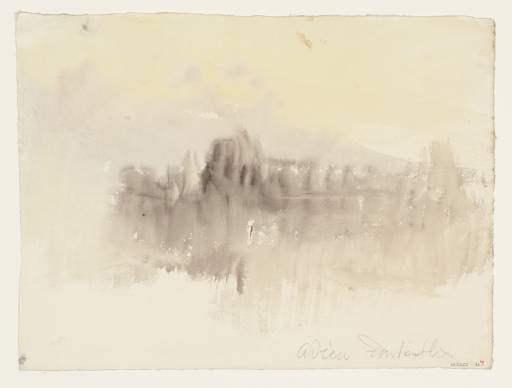Joseph Mallord William Turner Adieu Fontainebleau c.1841-2
Joseph Mallord William Turner,
Adieu Fontainebleau
c.1841-2
Joseph Mallord William Turner 1775–1851
Adieu Fontainebleau c.1841–2
D27546
Turner Bequest CCLXXX 29
Turner Bequest CCLXXX 29
Pencil and watercolour on paper, 221 x 292 mm
Inscribed in pencil by Turner ‘Adieu Fontainebleau’
Stamped in black ‘CCLXXX-29’ bottom right
Inscribed in red ink ‘29’ bottom right
Stamped with Turner Bequest monogram lower centre
Inscribed in pencil by Turner ‘Adieu Fontainebleau’
Stamped in black ‘CCLXXX-29’ bottom right
Inscribed in red ink ‘29’ bottom right
Stamped with Turner Bequest monogram lower centre
Accepted by the nation as part of the Turner Bequest 1856
Exhibition history
1974
Turner 1775–1851, Royal Academy, London, November 1974–March 1975 (638, as ‘Adieu Fontainebleau’, ?c.1845).
1978
Търнър, Shipka Gallery, Sofia, Bulgaria, April[?–May] 1978, Belgrade, Serbia [former Yugoslavia], May 1978, Muzeul de Arte al RS [Republica Socialista] Romania, Bucharest, June–July 1978 (68).
1981
J.M.W. Turner (1775–1851) / ΤΖ.Μ.Γ. Τερνερ (1775–1851), National Pinakothiki, Athens, January–March 1981 (64, reproduced in colour).
1983
J.M.W. Turner, à l’occasion du cinquantième anniversaire du British Council, Galeries nationales du Grand Palais, Paris, O ctober 1983–January 1984 (256, reproduced in colour).
1999
Turner on the Seine, Tate Gallery, London, June–October 1999, Pavillon des Arts, Paris, October 1999–January 2000, Musée Malraux, Le Havre, March–June 2000 (172, as ‘“Adieu Fontainebleau”’, early 1840s, reproduced).
References
1826
A.J. Finberg, A Complete Inventory of the Drawings of the Turner Bequest, London 1909, vol.II, p.893, CCLXXX 29, as ‘“Adieu Fontainebleau”’, c.1826–36.
1845
Andrew Wilton in Martin Butlin, Wilton and John Gage, Turner 1775–1851, exhibition catalogue, Royal Academy, London 1974, p.172 no.638, as ‘Adieu Fontainebleau’, ?c.1845.
1978
Timothy Clifford, Търнър, exhibition catalogue, Shipka Gallery, Sofia, Bulgaria 1978, no.68.
1980
Pierre Rouve, Turner, étude de structures, Paris 1980, reproduced p.187.
1981
Dimitrios Papastamos, John Gage and Lindsay Stainton, J.M.W. Turner (1775–1851) / ΤΖ.Μ.Γ. Τερνερ (1775–1851), exhibition catalogue, National Pinakothiki, Athens 1981, p.[152] no. 64, reproduced in colour.
1983
John Gage, Jerrold Ziff, Nicholas Alfrey and others, J.M.W. Turner, à l’occasion du cinquantième anniversaire du British Council, exhibition catalogue, Galeries nationales du Grand Palais, Paris 1983, p.306 no.256, reproduced in colour.
1988
Nicholas Alfrey, ‘Turner and the Cult of Heroes’, Turner Studies, vol.8, no.2, Winter 1988, p.44 note 22.
1993
Jan Piggott, Turner’s Vignettes, exhibition catalogue, Tate Gallery, London 1993, p.95, as ‘Inscribed “Adieu Fontainbleau”’.
1996
Denys Riout, Turner 1775 1851, Découvrons l’art, Paris 1996, reproduced p.6.
1999
Ian Warrell, Turner on the Seine, exhibition catalogue, Tate Gallery, London 1999, pp.58, 85, 87, 248, 280 no.172, as ‘“Adieu Fontainebleau”’, fig.52.
1841
Ian Warrell, Turner’s Sketchbooks, London 2014, reproduced in colour p.204, as ‘“Adieu Fontainebleau”’, c.1841–2.
This is one of thirteen loose sheets found grouped together, a number of which are believed to be ideas for compositions relating to the life of Napoleon; for more information see the Introduction to this section.
Turner inscribed this study ‘Adieu Fontainebleau’, allowing the subject to be identified as Napoleon’s departure from Fontainebleau following his abdication in 1814. This was also the subject of vignette Turner made in the 1830s (Indianapolis Museum of Art) as an illustration to Walter Scott’s Life of Napoleon, for which Turner had sourced engravings to familiarise himself ‘with all the stock Napoleonic imagery’.1 The art historian Nicholas Alfrey suggested Turner’s interpretation of the subject may draw on a composition by Horace Vernet (1789–1863), Les Adieux de Fontainebleau2; neither the vignette nor the present study bear much resemblance to Vernet’s picture, however. While the vignette is finely detailed and draws on Turner’s visit to Fontainebleau to gather material for his Scott illustrations in 1832, this later study lacks such clarity. The palace is very loosely depicted in a smoky grey and black strokes and there is little sign of figures or narrative outside of Turner’s inscription.
Turner seems to have returned to ideas surrounding the life of Napoleon following the former emperor’s reburial in 1840; as such this sheet probably represents an initial idea with regards to reinterpreting Turner’s earlier response to Napoleon quitting Fontainebleau. Napoleon respected Fontainebleau as well situated from a military and political perspective and important as ‘the real abode of Kings, the house of ages’3. In the present study Turner depicts the palace in quick, pale washes, which, although unfinished, nonetheless might be seen as evoking a sense of fading fortunes.
Verso:
As the sheet has been laid down on paper, the verso could not be checked at the time of cataloguing.
Elizabeth Jacklin
September 2018
How to cite
Elizabeth Jacklin, ‘Adieu Fontainebleau c.1841–2 by Joseph Mallord William Turner’, catalogue entry, September 2018, in David Blayney Brown (ed.), J.M.W. Turner: Sketchbooks, Drawings and Watercolours, Tate Research Publication, November 2019, https://www

